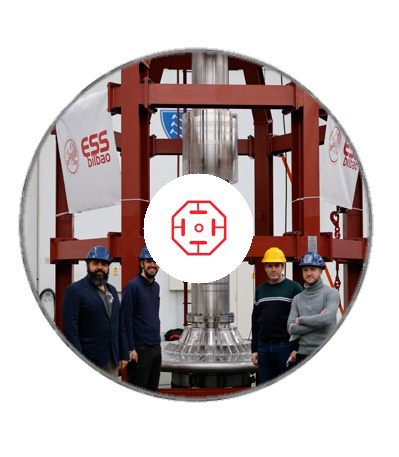Target Wheel
The target wheel designed consists of approximately 7,000 tungsten bricks cradled in 36 stainless steel, helium-cooled cassettes and wrapped in a pressurised stainless-steel vessel. The Helium is introduced by a coaxial pipe and circulates through several open volumes to guaranty and homogeneous inlet pressure in from of the cassette. The wheel turns at 23 1/3 RPMs as the proton beam falls on each segment at a frequency of about 0.5 Hz. The wheel spans 2.6 metres in diameter and weighs in at around five tonnes.
The target wheel stands as the core of the facility, where the spallation neutrons will be generated. As such, its design is a result of the conditions imposed by the beam, and its loads are influenced by all the elements around it. Therefore, any calculations regarding neutronics in it must consider the surroundings, i.e. The Target Station, which also includes the moderator, reflector, shielding, instrumentation plug, etc. In other words, elements that are not the work of ESS-Bilbao. This means that we need to share information and agree on a representative model.
Notice: Trying to access array offset on value of type bool in /home/essbilbao/public_html/wp-content/plugins/vc-extensions-bundle/cubebox/vc-extensions-cubebox.php on line 891
Shaft
Notice: Trying to access array offset on value of type bool in /home/essbilbao/public_html/wp-content/plugins/vc-extensions-bundle/cubebox/vc-extensions-cubebox.php on line 891
Drive unit
Notice: Trying to access array offset on value of type bool in /home/essbilbao/public_html/wp-content/plugins/vc-extensions-bundle/cubebox/vc-extensions-cubebox.php on line 891

The main functions of the Target Wheel are:
- Rotate the target wheel (23,33 rpm)
- Shield the neutrons produced in the spallation reaction in the target.
- Provide the target wheel with coolant (helium): The helium is injected (being the flow rate of 2,85 Kg/s [ESS-0060792]) from the helium rotary-seal and it flows downwards passing through all the shaft until it reaches the tungsten bricks (spallation material). After cooling the hotspot, the coolant goes upwards until it gets to the rotary seal. Therefore, there have to be designed two concentrically separated channels for the inlet and for the outlet helium flow, respectively. A requirement that the design needs to meet: the maximum pressure drop along all the loop must be lower than 0,85 bars [ESS- 0019346].
Target Wheel
Notice: Trying to access array offset on value of type bool in /home/essbilbao/public_html/wp-content/plugins/vc-extensions-bundle/cubebox/vc-extensions-cubebox.php on line 891
Target Wheel
Notice: Trying to access array offset on value of type bool in /home/essbilbao/public_html/wp-content/plugins/vc-extensions-bundle/cubebox/vc-extensions-cubebox.php on line 891
Target Wheel
Notice: Trying to access array offset on value of type bool in /home/essbilbao/public_html/wp-content/plugins/vc-extensions-bundle/cubebox/vc-extensions-cubebox.php on line 891




